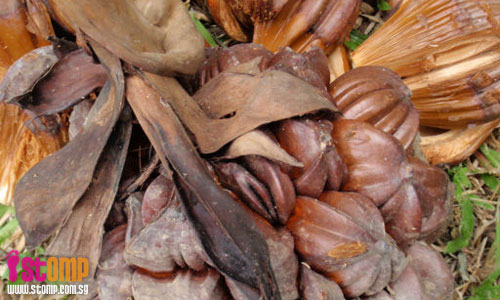
A STOMPer was peeved to see foreign workers plucking and eating the fruits from the trees in Admiralty Park. Furthermore, the empty husks of the eaten fruits were not cleared away. He says:
"These two pictures were taken at Admiralty Park at Riverside Road.
"This park is very popular with joggers, elderly folks and young people who enjoy inline skating.
"There is a notice at the entrance which advises all visitors not to remove the plants and animals found in the park.
"Last weekend I happened to stroll through the park when I noticed a group of foreign workers hacking off the huge fruit of the Nypa fruticans.
"This palm tree produces the succulent fruit called the attap chee used in our famous ice kachang.
"They used a parang and after chopping the giant fruit, they cut open the smaller fruits to enjoy the sweet pulp inside.
"Then they left the empty husks of the fruit behind and the whole place was littered with the remains of the fruit.
"I hope National Parks will send its wardens out more often to patrol this place to ensure that the fruits are not stolen and the trees are not damaged by this senseless and wanton destruction."

I had no idea the fruits of the nipah palm (Nypa fruticans) could be eaten just like that.
When I guide at the Chek Jawa boardwalk for the Naked Hermit Crabs, one of the things I am sure to talk about is the source of the attap chee that so many of us love to eat. Attap chee actually consists of unripe seeds of the nipah palm soaked in syrup. Many visitors do jokingly talk about gathering some of the nipah fruits we encounter. It's a waste if nobody utilises this resource, some of them might say, and I do agree with them to some degree. I'm sure the villagers who used to live in the area once depended on these nipah palms for food and materials.
But at the same time, it is possible that these fruits are an important food source for other species living in the mangroves. Even those left to fall to the ground and rot will help ensure that nutrients are recycled within the ecosystem. Besides, there is the possibility that some of these fruits might get dispersed to other shores, where they might germinate and establish new stands of nipah palms. After all, if I'm not wrong, the species is still considered locally endangered.
As for foreign workers entering our nature areas to gather food, there are quite a few things to consider. One is whether these workers are even aware of laws prohibiting people from collecting plants and animals from our parks. To them, a park might seem just like any other undeveloped area back in their home country, where anyone is free to enter and gather food and materials. Another point is whether they understand why we have these laws in place; many of our nature areas are already under a lot of pressure, and they could definitely do without further disturbance and intrusion. I doubt many of these parks are currently healthy or resilient enough to sustain utilisation for resources in the long term, even if it's just a low-impact activity like gathering fruit.
It is important to ensure that these foreigners know these restrictions, and that they comply with the law. Of course, if they are recalcitrant and carry on with such activities with the knowledge that what they are doing is illegal, then they will have to bear the full consequences if caught. Which would mean that increased surveillance and enforcement, not just by NParks employees, but also by members of the public, is also necessary.